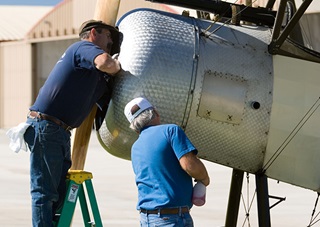
Washing and cleaning your airplane can be one of most relaxing and satisfying ways to spend a sunny afternoon. For most of us, owning an aircraft is an experience, rather than a means to an end. So, an opportunity to escape the stresses of daily life and spend some time reconnecting with your favorite treasure should be quite high on your priority list.
Of course, it’s not all about the Zen of “wax on, wax off.” Keeping your aircraft clean has significant benefits to its performance and long-term health. A dirty airframe is the devil’s playground for corrosion and you won’t win any races with a grimy belly.
So, let’s take this opportunity to go step-by-step over the best way to clean, inspect, and protect your aircraft.
Preparation
Begin with the Hippocratic Oath of aircraft cleaning: First, do no harm. This starts with you. Wash your hands and remove all jewelry. That ring of gold on your hand makes an excellent etching tool that will happily leave scratches and swirls all over your precious bird, ruining much more than your day.
You’ll also need plenty of water, clean towels, aluminum-safe degreaser and wash soap, Plexiglas cleaner, and an aircraft-specific paint sealant or wax.
 Before introducing any water spray, take the time to cover the static ports, pitot tube, angle of attack sensor, etc. so that water cannot get sprayed into them. That said, take the time to attach bright orange banner tape to each area you cover so that you do not forget to remove them when the job is done. Leaving critical ports or sensors covered prior to flight can have disastrous consequences. (After the crash of Aeroperú Flight 603 in 1996, investigators found that masking tape that had been applied to the static ports before cleaning had not been removed, leading to erroneous airspeed and altitude indications.)
Before introducing any water spray, take the time to cover the static ports, pitot tube, angle of attack sensor, etc. so that water cannot get sprayed into them. That said, take the time to attach bright orange banner tape to each area you cover so that you do not forget to remove them when the job is done. Leaving critical ports or sensors covered prior to flight can have disastrous consequences. (After the crash of Aeroperú Flight 603 in 1996, investigators found that masking tape that had been applied to the static ports before cleaning had not been removed, leading to erroneous airspeed and altitude indications.)
Airframe exterior cleaning
Every splattered bug and all the grit and grime adhered to the aircraft exterior is just sandpaper in the making, ready to be ground farther into the surrounding paint. The key is to remove it without capturing it underneath your cleaning tools.
With that priority in mind, here is the ultimate secret weapon of safe aircraft cleaning: your bare hand. It’s true. There isn’t a better tool on the planet for cleaning your bird. Forget the towels, scrubbing pads and microfiber; you’ve had the best cleaning device with you all along.
Start with simple, clean water. Use a hose on a low setting to flow water across the surface you’re working on. Let your hand glide across the surface, feeling every imperfection and contaminant. You’ll find that it’s fairly effortless to meter your pressure as required to remove anything stuck to the surface.
Use the same process for cleaning all of the aircraft Plexiglas. Personally, I like to soak the Plexiglas with a liberal coating of plastic-specific spray cleaner, and then use my bare hand to clean the glass in the same manner as you use on the paint.
With that step complete, you can safely move to the next phase of applying an aluminum-safe degreaser and/or bug remover as needed to get down to clean paint in the difficult spots. If you want an old-school, but very effective trick for cleaning the belly, simply get a good pair of gloves, eye protection, and a rag. Climb underneath the airplane and use those great little built-in 100LL dispensers on each wing to wet the rag. Wipe down the belly and the oil will be gone in no time. As long as you’re careful not to use too much fuel or let it linger on the paint for too long, it’s a quick and easy method of cleaning. As a last step, use an aircraft wash to completely remove any remaining oils or residual contaminants from the surface.
You’ll be left with a clean, blank slate from which you can take the next step of preserving and protecting. We’ll cover that next time. Until then, happy flying!
Interested in aircraft maintenance? View the archives of Jeff Simon’s Aircraft Maintenance series.
 Jeff Simon is an A&P mechanic, pilot, and aircraft owner. He has spent the last 14 years promoting owner-assisted aircraft maintenance as a columnist for several major aviation publications and through his how-to DVD series: The Educated Owner. Jeff is also the creator of SocialFlight, the free mobile app and website that maps over 20,000 aviation events, airport restaurants, and educational aviation videos, including many how-to videos for the subjects of these articles. Free apps are available for iPhone, iPad and Android, and on the Web at www.SocialFlight.com.
Jeff Simon is an A&P mechanic, pilot, and aircraft owner. He has spent the last 14 years promoting owner-assisted aircraft maintenance as a columnist for several major aviation publications and through his how-to DVD series: The Educated Owner. Jeff is also the creator of SocialFlight, the free mobile app and website that maps over 20,000 aviation events, airport restaurants, and educational aviation videos, including many how-to videos for the subjects of these articles. Free apps are available for iPhone, iPad and Android, and on the Web at www.SocialFlight.com.



